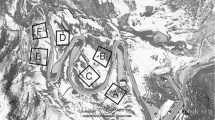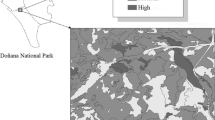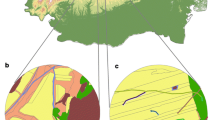Abstract
Firebreaks are linear strips that dissect the landscape and prevent or mitigate the spread of wildfires in Mediterranean landscapes. However, few studies have addressed their potential effect on insect behavior. The lack of traffic and other human activities in firebreaks makes them suitable for testing the sole effect of physical habitat disruption on animal movement. Our main objective was to evaluate whether the pattern of movement by a butterfly species was affected by this landscape element. We reconstructed flight trajectories of the lycaenid butterfly Plebejus argus within and around one firebreak using visual and GPS tracking in Doñana National Park (southern Spain). Butterflies that were active at the firebreak boundary often refused to enter the firebreak and, when they did, most individuals returned before reaching the opposite side. Inside the firebreak we recorded faster and straighter trajectories than in adjacent scrubland areas. Butterflies that crossed the firebreak headed the most favorable direction to minimize the time spent within the habitat discontinuity. At the landscape scale, firebreak density increased in areas where P. argus habitat was more fragmented and had lower quality. A narrow, open linear element lacking any human activity induces a marked change in the movement behavior of a butterfly species, with potential consequences on population dynamics at the landscape scale. Therefore, firebreaks used for protecting Mediterranean landscapes could have side effects on animal populations other than localized habitat loss due to mere vegetation removal.




Similar content being viewed by others
References
Aben J, Adriaensen F, Thijs KW, Pellikka P, Siljander M, Lens L, Matthysen E (2012) Effects of matrix composition and configuration on forest bird movements in a fragmented Afromontane biodiversity hotspot. Anim Conserv 15:658–666
Andersson P, Koffman A, Sjödin NE, Johansson V (2017) Roads may act as barriers to flying insects: species composition of bees and wasps differs on two sides of a large highway. Nat Conserv 18:47–59
Andrews KM, Gibbons JW (2005) How do highways influence snake movement? Behavioral responses toroads and vehicles. Copeia 4:772–782
Angulo E, Boulay R, Rodrigo A, Retana J, Cerda X (2007) Efecto de una especie invasora, Linepithemahumile, la hormiga argentina sobre la biodiversidad del Parque Nacional de Doñana (Huelva): descripción de las interacciones con las hormigas nativas. In: Ramírez L, Asensio B (eds) Proyectos de investigación en parques nacionales: 2003-2006. Organismo Autónomo de Parques Nacionales, Ministerio de Medio Ambiente, Madrid, pp 161–179
Baker MB, Rao S (2004) Incremental costs and benefits shape natal dispersal: theory and example with Hemilepistus reaumuri. Ecology 85:1039–1051
Bartoń K (2013) MuMIn: multi-model inference. R package version 1.15.6
Baxter-Gilbert JH, Riley JL, Neufeld CJH, Litzgus JD, Lesbarreres D (2015) Road mortality potentially responsible for billions of pollinating insect deaths annually. J Insect Conserv 19(5):1029–1035. https://doi.org/10.1007/s10841-015-9808-z
Bergerot B, Merckx T, van Dyck H, Baguette M (2012) Habitat fragmentation impacts mobility in a common and widespread woodland butterfly: do sexes respond differently? BMC Ecol 12:5
Beyer HL (2004) Hawth’s analysis tools for ArcGIS. http://www.spatialecology.com/htools. Accessed Jan 2019
Bolker BM, Brooks ME, Clark CJ, Geange SW, Poulsen JR, Stevens MHH, White J-SS (2009) Generalized linear mixed models: a practical guide for ecology and evolution. Trends Ecol Evol 24:127–135
Bowler DE, Benton TG (2005) Causes and consequences of animal dispersal strategies: relating individual behavior to spatial dynamics. Biol Rev 80:205–225
Brommer JE, Fred MS (1999) Movement of the Apollo butterfly Parnassiusapollo related to host plant and nectar plant patches. Ecol Entomol 24:125–131
Burnham KP, Anderson DR (2002) Model selection and multimodel inference: a practical information-theoretic approach, 2nd edn. Springer, New York
Clobert J, Le Galliard JF, Cote J, Meylan S, Massot M (2009) Informed dispersal, heterogeneity in animal dispersal syndromes and the dynamics of spatially structured populations. Ecol Lett 12:197–209
Collinge SK, Palmer TM (2002) The influences of patch shape and boundary contrast on insect response to fragmentation in California grasslands. Landsc Ecol 17:647–656
Conradt L, Roper TJ (2006) Nonrandom movement behavior at habitat boundaries in two butterfly species: implications for dispersal. Ecology 87:125–132
Crone EE, Schultz CB (2008) Old models explain new observations of butterfly movement at patch edges. Ecology 89:2061–2067
Dover JW, Fry GLA (2001) Experimental simulation of some visual and physical components of a hedge and the effects on butterfly behaviour in an agricultural landscape. Entomol Exp Appl 100:221–233
Dover JW, Rowlingson B (2005) The western jewel butterfly (Hypochrysopshalyaetus): factors affecting adult butterfly distribution within native Banksia bushland in an urban setting. Biol Conserv 122:599–609
ESRI (2008) ArcGIS desktop: release 9.3. Redlands, CA: Environmental Systems Research Institute
Eycott AE, Stewart GB, Buyung-Ali LM, Bowler DE, Watts K, Pullin AS (2012) A meta-analysis on the impact of different matrix structures on species movement rates. Landsc Ecol 27:1263–1278
Fahrig L (2007) Non-optimal animal movement in human-altered landscapes. Funct Ecol 21:1003–1015
Fernández P, Gutiérrez D, Jordano D, Fernández Haeger J (2017) Water availability drives habitat quality for the butterfly Plebejus argus in a Mediterranean sand dune landscape. J Insect Conserv 21:873–883
Fernández P, Jordano J, Fernandez Haeger J (2015) Living on the edge in species distribution models: the unexpected presence of three species of butterflies in a protected area in southern Spain. Ecol Model 312:335–346
Fernández P, Rodríguez A, Obregón R, De Haro S, Jordano D, Fernández Haeger J (2016) Fine scale movements of the butterfly Plebejus argus in a heterogeneous natural landscape as revealed by GPS tracking. J Insect Behav 29:80–98
Goff J, Yerke C, Keyghobadi N, Matter SF (2018) Dispersing male Parnassius smintheus butterflies are more strongly affected by forest matrix than are females. Insect Sci 26:932–944. https://doi.org/10.1111/1744-7917.12592
Gutiérrez D, Seymour AS, Fernández P, Fernández Haeger J, Jordano D (2004) Estructura espacial y dispersión de las poblaciones de mariposas: modelos y experimentos con Plebejus argus en Doñana. In Ecología insular. Fernandez-Palacios JM and Morici C (Eds). Asociación española de ecología terrestre (AEET). Cabildo insular de la Palma. La Palma, pp 147–179
Gutiérrez D, Fernández P, Seymour AS, Jordano D (2005) Habitat distribution models: are mutualist distributions good predictors of their associates? Ecol Appl 15:3–18
Hawkes C (2009) Linking movement behavior, dispersal and population processes: is individual variation a key? J Anim Ecol 78:894–906
Haynes KJ, Cronin JT (2006) Interpatch movement and edge effects: the role of behavioral responses to the landscape matrix. Oikos 113:43–54
Haynes KJ, Dillemuth FP, Anderson BJ, Hakes AS, Jackson HB, Jackson SE, Cronin T (2007) Landscape context outweighs local habitat quality in its effects on herbivore dispersal and distribution. Oecologia 151:431–441
Jordano D, Rodríguez J, Thomas CD, Fernández Haeger J (1992) The distribution and density of a lycaenid butterfly in relation to Lasius ants. Oecologia 91:439–446
Kallioniemi E, Zannese A, Tinker JE, Franco AMA (2014) Inter- and intra-specific differences in butterfly behaviour at boundaries. Insect Conserv Divers 7:232–240
Kareiva PM, Shigesada N (1983) Analyzing insect movement as a correlated random walk. Oecologia 56:234–238
Keilsohn W, Narango DL, Tallamy DW (2018) Roadside habitat impacts insect traffic mortality. Insect Conserv 22:183–188
Keret N, Välimäki P, Mutanen M, Shanas U (2015) Large roads disrupt insect movement: a case study of the Spodoptera littoralis (Lepidoptera: Noctuidae). J Insect Behav 28:544–554
Kovach Computing Services (2005) Oriana Version 3. http://www.kovcomp.co.uk/oriana/. Accessed Jan 2019
Kubo M, Kobayashi T, Kitahara M, Hayashi A (2009) Seasonal fluctuations in butterflies and nectar resources in a semi-natural grassland near Mt. Fuji, central Japan. Biodivers Conserv 18:229–246
Lebeau J, Wesselingh RA, Van Dyck H (2016) Nectar resource limitation affects butterfly flight performance and metabolism differently in intensive and extensive agricultural landscapes. Proc Biol Sci 283(1830):20160455. https://doi.org/10.1098/rspb.2016.0455
Leidner AK, Haddad NM (2010) Natural, not urban, barriers define population structure for a coastal endemic butterfly. Conserv Genet 11:2311–2320
Lewis OT, Thomas CD, Hill JK, Brookes MI, Crane TPR, Graneau YA, Mallet JLB, Rose OC (1997) Three ways of assessing metapopulation structure in the butterfly Plebejus argus. Ecol Entomol 22:283–293
Loos J, Kuussaari M, Ekroos J, Hanspach J, Fust P, Jackson L, Fischer J (2015) Changes in butterfly movements along a gradient of land use in farmlands of Transylvania (Romania). Lands Ecol 30:625–635
Mair L, Thomas CD, Franco AMA, Hill JK (2015) Quantifying the activity levels and behavioural responses of butterfly species to habitat boundaries. Ecol Entomol 40:823–828
Mazer CL, Appel AG (2001) Water loss and desiccation tolerances of long wing butterflies (Lepidoptera: Nymphalidae). Environ Entomol 30:631–636
Merckx T, van Dyck H, Karlsson B, Leimar O (2003) The evolution of movements and behavior at boundaries in different landscapes: a common arena experiment with butterflies. Proc R Soc Lond B 270:1815–1821
Morales JM, Moorcroft PR, Matthiopoulos J, Frair JL, Kie JG, Powell RA, Merrill EH, Haydon DT (2010) Building the bridge between animal movement and population dynamics. Philos Trans R Soc Lond B 365:2289–2301
Munguira ML, Thomas JA (1992) Use of road verges by butterfly and burnet populations, and the effect of road on adult dispersal and mortality. J Appl Ecol 29:316–329
Muñoz PT, Torres FP, Megías AG (2015) Effects of roads on insects: a review. Biodivers Conserv 24:659–682
Ohwaki A, Hayami S, Kitahara M, Yasuda T (2018) The role of linear mown firebreaks in conserving butterfly diversity: effects of adjacent vegetation and management. Entomol Sci 21:112–123
Pereira M, Rodríguez A (2010) Conservation value of linear woody remnants for two forest carnivores in a Mediterranean agricultural landscape. J Appl Ecol 47:611–620
Pinheiro J, Bates D, DebRoy S, Sarkar D (2014) nlme: linear and nonlinear mixed effects models. R package version 3.1-118. http://CRAN.R-project.org/package=nlme. Accessed Jan 2019
Plana E, Cerdán R, Castellnou M (2005) Developing firebreaks. In: Mansourian S, Vallauri D (eds) Forest restoration in landscapes: beyond planting trees. Springer, New York, pp 269–273
Polic D, Fiedler K, Nell C, Grill A (2014) Mobility of ringlet butterflies in high-elevation alpine grassland: effects of habitat barriers, resources and age. J Insect Conserv 18:1153–1161
R Development Core Team (2013) R: a language and environment for statistical computing. R Foundation for Statistical Computing, Vienna. http://www.R-project.org/. Accessed Jan 2019
Revilla E, Wiegand T (2008) Individual movement behavior, matrix heterogeneity, and the dynamics of spatially structured populations. Proc Natl Acad Sci USA 105:19120–19125
Richards SA, Whittingham MJ, Stephens PA (2011) Model selection and model averaging in behavioural ecology: the utility of the IT-AIC framework. Behav Ecol Sociobiol 65:77–89
Ries L, Debinski DM (2001) Butterfly responses to habitat edges in the highly fragmented prairies of Central Iowa. J Anim Ecol 70:840–852
Ries L, Sisk TD (2004) A predictive model of edge effects. Ecology 85:2917–2926
Rodríguez J, Fernández Haeger J, Jordano D (1991) El ciclo biológico de Plebejus argus (Linnaeus, 1758) en el Parque Nacional de Doñana (SW de España). (Lepidoptera: Lycaenidae.) SHILAP. Rev Lepid 19:241–252
Román J, Barón A, Revilla E (2010) Descripción de la red de caminos del Espacio Natural Doñana. In: Román J, Barón A, Revilla E (eds) Evaluación de los efectos del tránsito a motor sobre especies y comunidades de interés en el Espacio Natural de Doñana. Consejería de Medio Ambiente de la Junta de Andalucía y Estación Biológica de Doñana (CSIC), Sevilla, pp 7–40
Ruiz-Mirazo J, Robles AB, González Rebollar JL (2011) Two-year evaluation of fuelbreaks grazed by livestock in the wildfire prevention program in Andalusia (Spain). Agric Ecosyst Environ 141:13–22
Schtickzelle N, Baguette M (2003) Behavioral responses to habitat patch boundaries restrict dispersal and generate emigration–patch area relationships in fragmented landscapes. J Anim Ecol 72:533–545
Schtickzelle N, Joiris A, van Dyck H, Baguette M (2007) Quantitative analysis of changes in movement behaviour within and outside habitat in a specialist butterfly. BMC Evol Biol 7:4
Schultz CB, Crone EE (2001) Edge-mediated dispersal behavior in a prairie butterfly. Ecology 82:1879–1892
Schultz CB, Franco AMA, Crone EE (2012) Response of butterflies to structural and resource boundaries. J Anim Ecol 81:724–734
Schultz CB, Haddad NM, Henry EH, Crone EE (2019) Movement and demography of at-risk butterflies: building blocks for conservation. Annu Rev Entomol 64:167–184. https://doi.org/10.1146/annurev-ento-011118-112204
Seymour A, Gutiérrez D, Jordano D (2003) Dispersal of the lycaenid P. argus in response to patches of its mutualist ant L. niger. Oikos 103:162–174
Shepard DB, Kuhns AR, Dreslik MJ, Phillips CA (2008) Roads as barriers to animal movement in fragmented landscapes. Anim Conserv 11:288–296
Skórka P, Lenda M, Moroń D, Kalarus K, Tryjanowski P (2013) Factors affecting road mortality and the suitability of road verges for butterflies. Biol Conserv 159:148–157
Smith RG (2000) Assessment of the status of the silver-studded blue Plebejus argus on Castlemartin ranges, s. Pembrokeshire. Countryside Council for Wales (CCW contract science). Nº. 372. ASIN: B0018TNH0 M
StatSoft Inc. (2007) STATISTICA (data analysis software system), version 8.0. www.statsoft.com. Accessed Jan 2019
St-Louis V, Pidgeon AM, Clayton MK, Locke BA, Bash D, Radeloff VC (2010) Habitat variables explain Loggerhead Shrike occurrence in the northern Chihuahuan Desert, but are poor correlates of fitness measures. Lands Ecol 25:643–654
Suárez-Esteban A, Delibes M, Fedriani JM (2013) Barriers or corridors? The overlooked role of unpaved roads in endozoochorous seed dispersal. J Appl Ecol 50:767–774
Suárez-Esteban A, Delibes M, Fedriani JM (2014) Unpaved roads disrupt the effect of herbivores and pollinators on the reproduction of a dominant shrub. Basic Appl Ecol 15:524–533
Tamayo P, Pascual F, González Megías A (2015) Effects of roads on insects: a review. Biodivers Conserv 24(3):659–682. https://doi.org/10.1007/s10531-014-0831-2
Thomas CD, Harrison S (1992) Spatial dynamics of a patchily distributed butterfly species. J Anim Ecol 61:437–446
Turchin P (1991) Translating foraging movements in heterogeneous environments into the spatial distribution of foragers. Ecology 72:1253–1266
Turchin P (1998) Quantitative analysis of movement: measuring and modeling population redistribution in plants and animals. Sinauer Associates, Sunderland
van Dyck H (2012) Changing organisms in rapidly changing anthropogenic landscapes: the significance of the ‘Umwelt’-concept and functional habitat for animal conservation. Evol Appl 5:144–153
van Dyck H, Baguette M (2005) Dispersal behavior in fragmented landscapes: routine or special movements? Basic Appl Ecol 6:535–545
Van Horne B (1983) Density as a misleading indicator of habitat quality. J Wildl Manag 47:893–901
Zar JH (1984) Biostatistical analysis. Prentice-Hall Inc, Englewood Cliffs
Zuur AF, Ieno EN, Walker NJ, Saveliev AA, Smith G (2009) Mixed effects models and extensions in ecology with R. Springer, New York
Acknowledgements
This research was funded by the Consejería de Innovación, Ciencia y Empresa, Junta de Andalucía (Grant P06-RNM-1903 to A. Rodríguez). Special thanks to Doñana National Park and the Estación Biológica de Doñana that provided permission and support for working in the field. Rafael Obregón and Laura Gil helped with the field work. Two anonymous referees provided helpful comments on the manuscript.
Author information
Authors and Affiliations
Corresponding author
Ethics declarations
Conflict of interest
Authors have no conflict of interest.
Ethical approval
Butterfly tracking was conducted with relevant permissions provided by the Doñana National Park.
Additional information
Publisher's Note
Springer Nature remains neutral with regard to jurisdictional claims in published maps and institutional affiliations.
Electronic supplementary material
Below is the link to the electronic supplementary material.
Rights and permissions
About this article
Cite this article
Fernández, P., Rodríguez, A., Gutiérrez, D. et al. Firebreaks as a barrier to movement: the case of a butterfly in a Mediterranean landscape. J Insect Conserv 23, 843–856 (2019). https://doi.org/10.1007/s10841-019-00175-5
Received:
Accepted:
Published:
Issue Date:
DOI: https://doi.org/10.1007/s10841-019-00175-5




